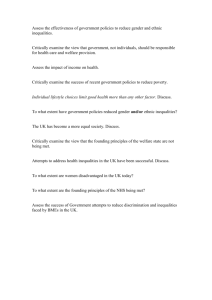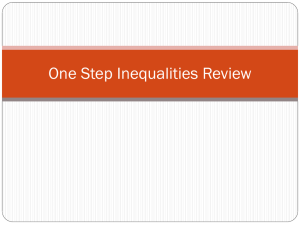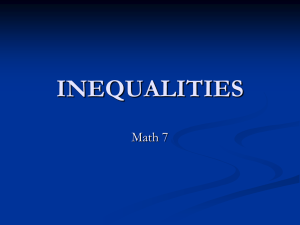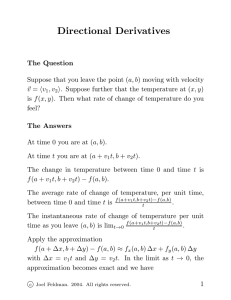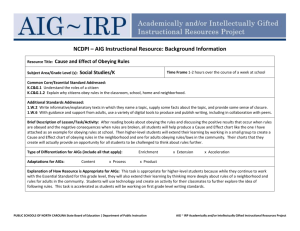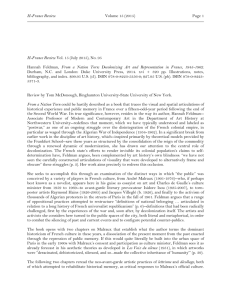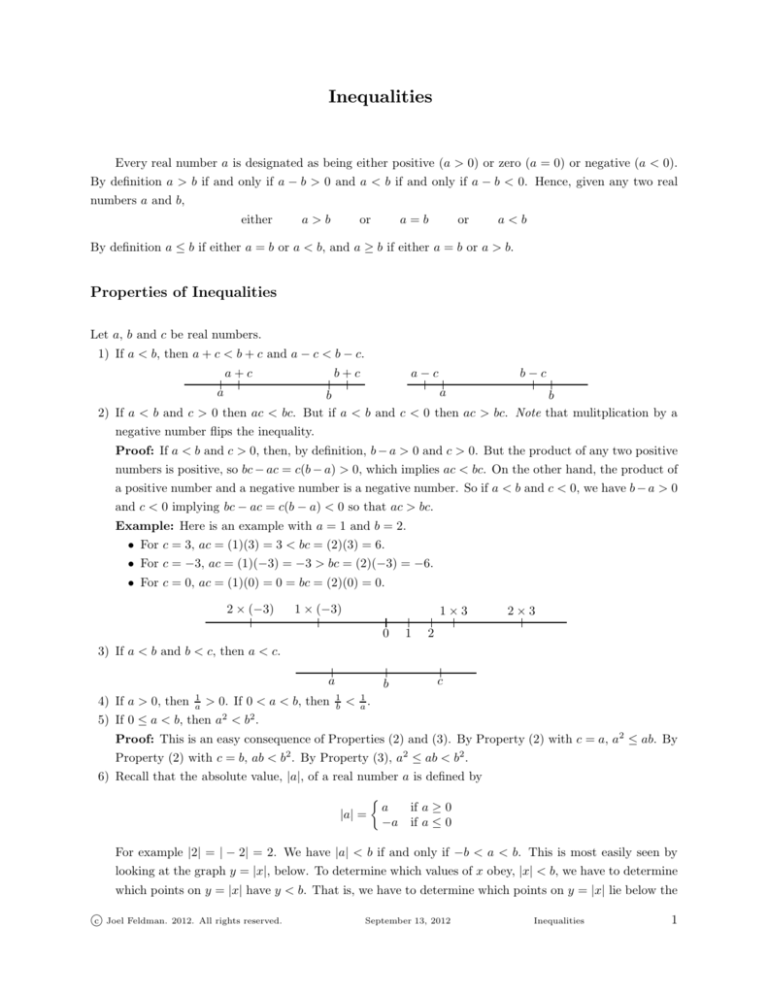
Inequalities
Every real number a is designated as being either positive (a > 0) or zero (a = 0) or negative (a < 0).
By definition a > b if and only if a − b > 0 and a < b if and only if a − b < 0. Hence, given any two real
numbers a and b,
either
or
a>b
a=b
or
a<b
By definition a ≤ b if either a = b or a < b, and a ≥ b if either a = b or a > b.
Properties of Inequalities
Let a, b and c be real numbers.
1) If a < b, then a + c < b + c and a − c < b − c.
a+c
b+c
a−c
a
b−c
a
b
b
2) If a < b and c > 0 then ac < bc. But if a < b and c < 0 then ac > bc. Note that mulitplication by a
negative number flips the inequality.
Proof: If a < b and c > 0, then, by definition, b − a > 0 and c > 0. But the product of any two positive
numbers is positive, so bc − ac = c(b − a) > 0, which implies ac < bc. On the other hand, the product of
a positive number and a negative number is a negative number. So if a < b and c < 0, we have b − a > 0
and c < 0 implying bc − ac = c(b − a) < 0 so that ac > bc.
Example: Here is an example with a = 1 and b = 2.
• For c = 3, ac = (1)(3) = 3 < bc = (2)(3) = 6.
• For c = −3, ac = (1)(−3) = −3 > bc = (2)(−3) = −6.
• For c = 0, ac = (1)(0) = 0 = bc = (2)(0) = 0.
2 × (−3)
1 × (−3)
1×3
0
1
2×3
2
3) If a < b and b < c, then a < c.
a
4) If a > 0, then
1
a
> 0. If 0 < a < b, then
2
b
1
b
<
c
1
a.
2
5) If 0 ≤ a < b, then a < b .
Proof: This is an easy consequence of Properties (2) and (3). By Property (2) with c = a, a2 ≤ ab. By
Property (2) with c = b, ab < b2 . By Property (3), a2 ≤ ab < b2 .
6) Recall that the absolute value, |a|, of a real number a is defined by
|a| =
a
if a ≥ 0
−a if a ≤ 0
For example |2| = | − 2| = 2. We have |a| < b if and only if −b < a < b. This is most easily seen by
looking at the graph y = |x|, below. To determine which values of x obey, |x| < b, we have to determine
which points on y = |x| have y < b. That is, we have to determine which points on y = |x| lie below the
c Joel Feldman.
2012. All rights reserved.
September 13, 2012
Inequalities
1
line y = b. The point (x, |x|) on the graph y = |x| lies below the line y = b if and only if x is between
−b and b.
y = |x|
y
y=b
−b
x
b
√
Example 1 Find all real numbers x obeying | x − 3| < 10−6 .
Solution.
√
√
| x − 3| < 10−6 ⇐⇒ −10−6 < x − 3 < 10−6
√
⇐⇒ 3 − 10−6 < x < 3 + 10−6
⇐⇒ (3 − 10
−6 2
) < x < (3 + 10
Example 2 Find all real numbers x obeying
Solution. If x − 1 < 0, then
2
x−1
2
x−1
by Property (6)
by Property (1) with c = 3
−6 2
)
by Property (5)
≥ 5.
< 0 while 5 > 0. So no x’s with x − 1 < 0, that is x < 1, are allowed.
2
x−1
If x − 1 = 0, that is x = 1, then
is not defined. In this case, we say the inequality
satisified.
2
x−1
≥ 5 is not
If x − 1 > 0, that is x > 1,
2
x−1
≥ 5 ⇐⇒ 2 ≥ 5(x − 1)
⇐⇒
⇐⇒
So the allowed x’s are 1 < x ≤
7
5
2
5
7
5
by Property (2) with c = x − 1 > 0
1
5
≥x−1
by Property (2) with c =
≥x
by Property (1) with c = 1
. We can also see this from the graph below.
y=
y
2
x−1
( 75 , 5)
1
y=5
x
The interval of all real numbers x that obey 1 < x ≤ 57 is denoted 1, 57 . The round bracket in “ 1” signifies
that 1 is not included in the interval while the square bracket in “ 75 ” signifies that 57 is included in the
interval.
Example 3 Find all real numbers x obeying −x2 + 3x + 4 > 0.
c Joel Feldman.
2012. All rights reserved.
September 13, 2012
Inequalities
2
Solution. Factoring
−x2 + 3x + 4 = −(x2 − 3x − 4) = −(x − 4)(x + 1)
If the two factors (x − 4) and (x + 1) have the same sign (either both positive or both negative) then
(x − 4)(x + 1) will be positive and −x2 + 3x + 4 = −(x − 4)(x + 1) will be negative. Hence we need the two
factors (x − 4) and (x + 1) to have opposite sign. That is, we need −1 < x < 4 . This is consistent with the
graph below.
y
−1
4
x
y = −x2 + 3x + 4
c Joel Feldman.
2012. All rights reserved.
September 13, 2012
Inequalities
3


